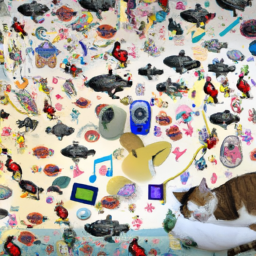Ever observed your cat during its sleep and seen their paws jerking or their whiskers trembling? It’s quite intriguing to speculate on what dreams might be running through their heads.
As a cat lover, I’ve always been fascinated by felines and their mysterious behaviors. So, when I discovered that cats can dream just like humans do, my curiosity was piqued even more!
In this article, we’ll explore the theories behind cat dreams and try to understand what our furry friends might be experiencing while they slumber.
As much as we love our cats, it’s no secret that they can be enigmatic creatures. From their odd habits to their distinctive personalities, there’s always something new to learn about them.
That’s why understanding what goes on in their minds while they’re sleeping is particularly intriguing. Although we can’t exactly ask them directly what they’re dreaming about (if only!), there are some clues we can use to decipher the meaning behind those sleepy behaviors.
So buckle up for a fascinating journey into the world of cat dreams!
Key Takeaways
- Cat dreams are linked to their daily experiences and instincts, and can indicate hunting and predatory instincts, anxiety and stress, or feelings of comfort and security.
- Understanding your cat’s behaviors during sleep, such as purring, twitching whiskers, or crying out, can help decode their meanings and promote better sleep habits.
- Sleep disorders such as insomnia, sleep apnea, and narcolepsy can affect cats and should be managed with professional help from a veterinarian.
- Relaxation techniques, such as familiar scents and cozy beds, can help calm a cat’s nerves and promote a peaceful slumber. Cultural interpretations of cat dreams may symbolize mystery, intuition, innocence, vulnerability, or companionship during times of stress or transition.
Understanding Cat Sleep
Cat sleep is different from human sleep, so it’s important to understand their unique needs and behaviors. Understanding feline sleep patterns can help us promote healthy habits for our furry friends.
Cats are crepuscular creatures, which means they are most active during dawn and dusk. Therefore, they tend to take shorter naps throughout the day and night instead of sleeping for long periods like humans.
To ensure that your cat gets enough restful sleep, it’s essential to create a comfortable environment for them. Make sure their bedding is soft and cozy, and place it in a quiet area away from any distractions or noise. Providing toys for playtime during waking hours can also help them expend energy and encourage better sleep at night. Additionally, feeding your cat a balanced diet with the right nutrients can contribute to more profound slumber.
Tips for promoting healthy cat sleep habits include setting a routine bedtime schedule with consistent feeding times and exercise sessions. Avoiding sudden changes in their environment or daily routine can also reduce stress levels that could disrupt their sleeping patterns.
By understanding feline sleep behavior and providing a supportive environment, we can ensure our beloved pets have sufficient restorative rest each day.
Understanding the essential components of feline sleep lays the groundwork for exploring theories on why cats dream during REM (Rapid Eye Movement) stages of deep slumber.
Theories on Cat Dreams
You might be surprised to learn that your feline friend’s nocturnal adventures could be compared to a magical journey through an enchanted forest. Just like humans, cats experience different stages of sleep, including REM (rapid eye movement), which is when most dreams occur.
While we can’t ask our pets what they dream about, many experts believe that cat dreams are linked to their daily experiences and instincts.
Here are three popular theories on cat dream symbolism and cultural interpretations:
-
Hunting: Many people believe that cats dream about hunting because of their natural instinct as hunters. In fact, some studies have shown that during REM sleep, a cat’s brain activity mimics the same patterns as when they are stalking prey in real life.
-
Health: Others interpret cat dreams as a reflection of their overall health and well-being. For example, if your cat is dreaming about playing with toys or chasing butterflies, it could indicate that they are happy and content. On the other hand, if they seem agitated or anxious in their dreams, it may suggest underlying health issues or stressors.
-
Cultural Beliefs: Finally, different cultures have varying interpretations of what cat dreams signify. In ancient Egyptian culture, for instance, cats were revered as sacred animals associated with good luck and prosperity. Therefore dreaming about cats was considered a positive omen.
As we’ve explored some theories on what cat dreams mean through cultural beliefs and symbolic representations like hunting or general health indications, it’s essential to note common behaviors displayed by our feline friends during these experiences without any disturbance from us humans.
Common Cat Dream Behaviors
Imagine waking up to your furry friend twitching, pawing, or even meowing in their sleep – these common behaviors during cat dreams can be both amusing and heartwarming to witness. As pet owners, we often wonder what goes on in our cats’ minds when they dream.
While cats are known for their independent nature, they’re also complex creatures that convey emotions through their behavior. These behaviors during cat dreams may hold a deeper meaning than we think. One way to decode cat dream symbolism is by observing recurring dream patterns.
Some common behaviors during cat dreams include twitching of the whiskers and tail, rapid eye movement, and vocalization such as meowing or purring. These actions might indicate that your feline friend is reliving an experience from their daily life or processing new information learned throughout the day. For example, if your cat twitches its paws while dreaming about chasing prey, it could suggest that they are reliving a hunting experience.
While some behaviors may have an apparent explanation behind them, others might leave us scratching our heads. However, it’s essential to remember that each cat has its unique personality and behavioral traits. Understanding your feline companion’s habits and quirks can help you decode the meanings behind their dream behaviors better.
In the subsequent section about "possible meanings behind cat dream behaviors,"we’ll explore different interpretations of these actions and how they relate to our furry friends’ personalities and emotions.
Possible Meanings Behind Cat Dream Behaviors
As someone who’s had many cat dreams, I’ve often wondered what they could mean. After researching the topic, I found that there are several possible meanings behind the behaviors exhibited in these dreams.
Hunting and predatory instincts may indicate a desire to assert control or power over a situation, while anxiety and stress could signify underlying emotional turmoil.
On the other hand, feelings of comfort and security may suggest a need for stability and reassurance in waking life.
Hunting and Predatory Instincts
Feeling the thrill of the hunt, my feline dreams tap into my inner predator and unleash a wild side that’s both exhilarating and instinctual.
As cats are natural hunters, it’s not uncommon for them to dream about chasing prey or engaging in playful hunting behavior. These dreams may be triggered by their nocturnal habits or simply by their innate predatory instincts.
Prey play is a common theme in cat dreams. They may be seen stalking, chasing, and pouncing on imaginary prey. This behavior is an indication of their natural instincts and serves as a way for them to hone their hunting skills even while sleeping.
However, it’s important to note that these dreams don’t necessarily mean that your cat is hungry or unsatisfied with its food. Rather, it’s simply a manifestation of their primal nature. With this in mind, it’s important to provide your cat with opportunities for play and exploration during waking hours to satisfy these instincts without causing harm to other animals.
As we move into the next section about anxiety and stress, it’s important to recognize how our feline friends’ dreams can also indicate underlying emotional states just like humans’.
Anxiety and Stress
As we’ve previously discussed, cats are natural hunters and their predatory instincts come through in their dreams. However, it’s important to note that not all cat dreams are about chasing prey.
Some cat dreams can be a reflection of their anxiety or stress levels. Cats may experience anxiety and stress due to a variety of reasons such as changes in their environment, separation from their owners, or the presence of other animals. These anxieties can manifest themselves in various ways including behavioral changes like excessive grooming or aggression towards humans and other pets.
Coping strategies for these anxieties include providing a consistent routine for your feline friend, creating safe spaces within the home where they can retreat when feeling overwhelmed, and providing plenty of interactive toys to stimulate mental activity. By recognizing and addressing these anxieties through behavioral changes and coping strategies, we can help our furry companions lead more fulfilling lives.
As much as cats crave independence, they also have an innate need for comfort and security. In the next section, we will explore how this need translates into their dreams and what it means for us as pet owners.
Comfort and Security
You can create a safe haven for your furry companion by providing them with everything they need to feel comfortable and secure. Relaxation techniques such as soft music or gentle stroking can help calm your cat’s nerves and soothe them into a peaceful slumber.
Additionally, familiar scents like their favorite blanket or toy can also provide a sense of security and comfort. Having a cozy bed and toys to snuggle with during their dreams can make all the difference in helping your cat feel at ease.
As pet owners, it’s our responsibility to ensure that our furry companions have everything they need to lead happy lives. By creating a safe and comforting environment for our cats, we’re not only fulfilling this responsibility but also strengthening the bond we share with these amazing creatures.
And now, let’s explore what these dreams could mean for our feline friends!
Interpreting Cat Dreams
Hey there, if you dream about cats, it could mean that your subconscious is trying to tell you something important about your intuition and independence. Exploring symbolism in your cat dreams can help you understand what message your mind is trying to communicate.
For example, dreaming of a black cat may symbolize mystery or intuition, while dreaming of a kitten may represent innocence or vulnerability. Psychological impact also plays a role in interpreting cat dreams.
If you have recently experienced a loss or significant change in your life, dreaming of a cat may signify comfort and companionship during this time of transition. Alternatively, if you’re feeling overwhelmed by responsibilities and stress, dreaming of a playful cat might indicate the need for more relaxation and playfulness in your waking life.
In order to gain a deeper understanding of the meaning behind your cat dreams, it can be helpful to keep a journal and write down any images or emotions that come up during these dreams. Sharing your cat’s dreams with others who have had similar experiences can also provide valuable insight into their meaning.
By exploring the symbolism and psychological impact within these dreams, you can unlock hidden messages from your subconscious that promote personal growth and well-being.
Sharing Your Cat’s Dreams
When sharing your feline-inspired dreams with others, it can provide a valuable opportunity for introspection and personal growth. Sharing experiences with others allows us to gain insight into our own thoughts and behaviors. It also helps us connect with other cat owners who may have similar experiences or insights.
Interpreting behaviors is an important part of understanding what our cats are trying to tell us. By sharing dreams, we can start to understand the underlying reasons behind certain behaviors. For example, if a cat is constantly meowing in a dream, it could be a sign that they are feeling anxious or stressed in their waking life.
To further emphasize the importance of interpreting behaviors, consider the following table:
| Behavior | Possible Meaning | Action |
|---|---|---|
| Purring while sleeping | Contentment and relaxation | Leave the cat alone |
| Twitching whiskers during sleep | Active dreaming | Observe but do not disturb |
| Crying out or moving vigorously during sleep | Restlessness or discomfort | Check on the cat’s physical needs |
By paying attention to these small cues, we can better understand our cats’ needs and create a stronger bond with them. Understanding common sleep disorders in cats will also help us provide better care for them.
Common Cat Sleep Disorders
I’ve noticed that my cat doesn’t always sleep soundly, and it turns out she may be suffering from one of the common sleep disorders that affect cats.
Insomnia, or difficulty falling asleep or staying asleep, is a problem for some felines just like it is for humans.
Sleep apnea, where breathing temporarily stops during sleep, can also affect cats and lead to disrupted rest.
Lastly, narcolepsy is another condition that affects some cats and causes them to fall asleep unexpectedly during the day.
Insomnia
If you’re struggling to fall asleep at night, managing insomnia can be a real challenge. However, there are several coping mechanisms that you can try to help alleviate this condition.
Firstly, establishing a regular sleep schedule can help regulate your body’s internal clock and promote better sleep quality. Secondly, limiting caffeine intake during the day and avoiding heavy meals before bedtime can also improve the chances of falling asleep faster.
Another way to combat insomnia is by creating a relaxing environment in your bedroom. This could involve dimming the lights or using soothing music or white noise to drown out distracting sounds. By implementing these strategies for managing insomnia, you may be able to achieve restful sleep more consistently.
Moving on from insomnia, let’s explore another common cat sleep disorder: sleep apnea.
Sleep Apnea
Managing sleep apnea can be challenging, but there are several effective treatments available to help alleviate this disruptive sleep disorder. Sleep apnea occurs when a person’s breathing is interrupted during sleep, causing them to wake up repeatedly throughout the night. Common symptoms of sleep apnea include loud snoring, gasping for air during sleep, and excessive daytime fatigue.
The most common treatment for sleep apnea is continuous positive airway pressure (CPAP) therapy, which involves wearing a mask that delivers pressurized air to keep the airway open during sleep. Other treatments may include lifestyle changes such as losing weight or avoiding alcohol and sedatives before bed. In severe cases, surgery may be necessary to correct anatomical abnormalities in the throat that contribute to the condition. If you suspect you have sleep apnea or are experiencing any of its symptoms, it’s important to speak with your healthcare provider for an accurate diagnosis and appropriate treatment plan.
As we move into discussing narcolepsy in the subsequent section, it’s important to note that while both conditions involve disruptions in normal sleep patterns, they are distinct disorders with different underlying causes and treatment approaches.
Narcolepsy
As we discussed previously, sleep apnea can have a significant impact on the quality of sleep for both humans and animals. However, there’s another sleep disorder that’s equally concerning – narcolepsy.
Narcolepsy is a neurological condition that affects the brain’s ability to regulate wakefulness and sleep cycles. People with narcolepsy often experience excessive daytime sleepiness, sudden episodes of muscle weakness or paralysis (known as cataplexy), and vivid dreams.
If you suspect that your cat may be suffering from narcolepsy, it’s important to explore treatment options with your veterinarian. While there’s no cure for this condition, medications such as stimulants and antidepressants can help manage symptoms and improve quality of life. Additionally, making lifestyle changes such as establishing consistent routines and providing a comfortable sleeping environment can also be beneficial.
Here are some key considerations for managing narcolepsy in pets:
- Medication management
- Lifestyle changes
- Consistent routine
- Comfortable sleeping environment
- Regular veterinary check-ups
Living with a pet who has narcolepsy can certainly present some challenges, but it doesn’t have to limit their abilities or diminish their quality of life. By working closely with your veterinarian to create an individualized treatment plan for your furry friend, you can help them live happily and comfortably despite their condition.
When to consult a veterinarian about potential sleep disorders in cats? Let’s find out in the next section!
When to Consult a Veterinarian
Oh, you definitely don’t need to call a vet when your cat dreams of chasing mice and birds – but if Fluffy starts meowing in her sleep for hours on end, it might be time to schedule an appointment. Behavioral changes are usually the first signs that something is wrong with your furry friend. If you notice any sudden changes in their sleeping habits or vocalizations during sleep, it could indicate a medical issue.
Consulting a veterinarian can help rule out any potential health problems that may be causing these behavioral changes during sleep. They will conduct a physical exam and ask about your cat’s medical history to determine the underlying cause of their symptoms. In some cases, medications or behavioral therapy may be recommended to help alleviate these issues.
Ultimately, consulting a veterinarian when you notice unusual behavior in your cat while they are sleeping can save them from experiencing unnecessary discomfort or pain. As pet owners, it is our responsibility to ensure the well-being of our furry friends by seeking professional help when needed. Remember, even though cats can’t communicate with us verbally, they still rely on us to take care of them and keep them healthy.
| Table | Emotions Evoked |
|---|---|
| Neglected | Guilt |
| Peaceful | Relief |
| Caring | Responsibility |
Frequently Asked Questions
Can cats have nightmares?
I’ve explored the possibility of cats having nightmares and it’s likely they do. Causes can include stress, illness or trauma. Prevention strategies include creating a calm environment, regular exercise and playtime, and seeking veterinary care if necessary.
Do all cats dream?
As a pet researcher, I can confirm that all cats dream. Common dream scenarios include chasing prey or playing with toys. Dream length and frequency vary but usually occur during the REM stage of sleep.
Can my cat’s dreams reflect their personality?
Yes, a cat’s dreams can reflect their personality traits and behavior. Interpreting dream behavior can reveal insights into their temperament and habits. Understanding these aspects of your feline companion can lead to better care and nurturing.
Can a cat’s dream behavior change over time?
As a cat owner, I’ve noticed my feline’s dream patterns change over the years. Exploring frequency and duration, I found environmental changes impacted their dream behavior. With patience and love, we adapted together.
Do cat dreams have any impact on their waking behavior or mood?
Exploring the science, significance, and myths behind cat dreams reveals a potential connection between their dreams and emotional wellbeing. While more research is needed, it’s possible that a cat’s dream content could impact their waking behavior or mood.
Conclusion
In conclusion, understanding our feline friends’ sleeping habits and dreams can offer us insight into their behavior and emotions. While theories on cat dreams vary, common behaviors such as twitching, purring, and kneading may indicate different meanings behind their slumber.
As pet owners, it’s important to observe our cats during sleep and consider any changes in their behavior or sleep patterns. Interestingly, according to a study by the American Pet Products Association, approximately 42.7 million households in the United States own at least one cat.
With such a large number of feline companions in our homes, it’s essential we understand and appreciate their unique personalities and needs – even when they’re fast asleep. By learning more about cat dreams and sleep disorders, we can provide the best possible care for our furry family members.
If you have any concerns about your cat’s sleep patterns or behavior during sleep, consult with a veterinarian who can offer professional guidance.









